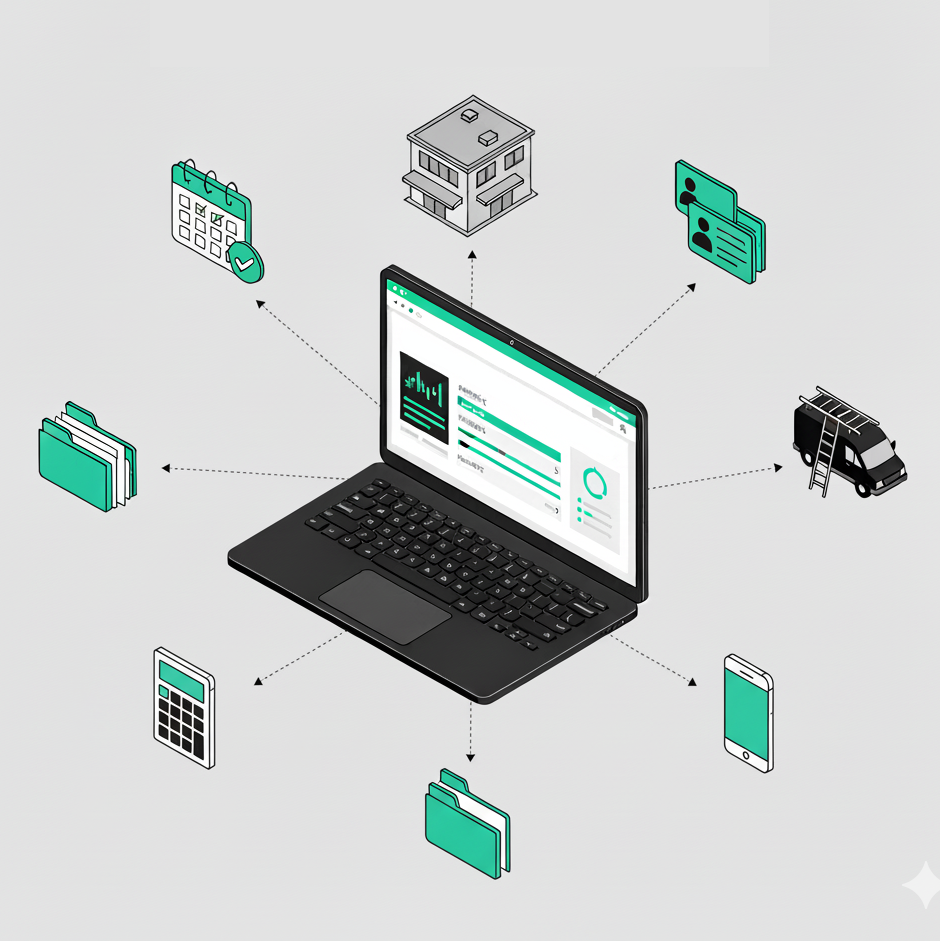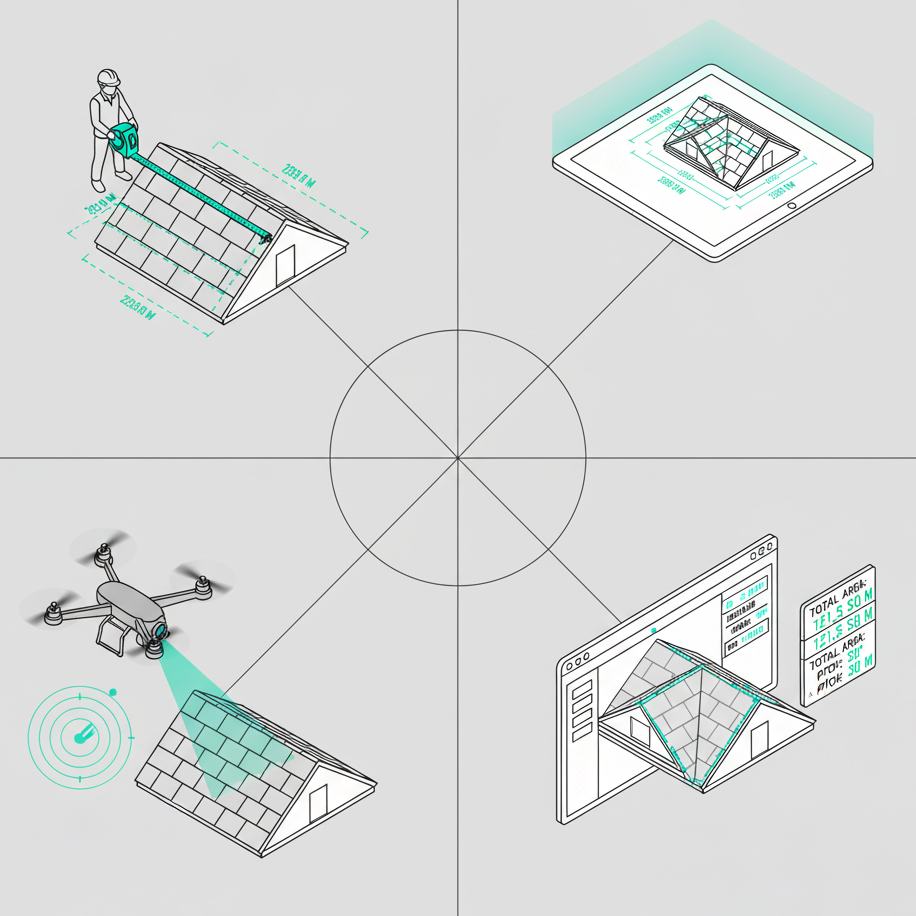The best drones for PV planners, roofers and carpenters 2025


In the craft sector, drones are increasingly being integrated into everyday working life due to their enormous potential and benefits. Dacheckers, carpenters and PV planners benefit from the wide range of applications of this technology. In this article, we would like to explain to you in more detail what to look for when choosing drones and which drone is best suited to the specific needs of these target groups.
.jpeg)
The most important features of a drone
In the following, we would like to give you a brief overview of the most important and interesting technical features of a drone. In doing so, we focus less on technical details and more on the benefits that this technology offers.
The built-in cameras A drone varies depending on the model. With camera sensors, the number of pixels determines the sharpness of an image. A camera with more megapixels therefore offers sharper image quality. The quality of the recordings also depends on the size of the built-in camera sensor.
Die Obstacle sensors During the flight, a drone can use these sensors to check whether there are obstacles in its path or whether the airspace is clear. When an obstacle is detected, the sensors prevent maneuvering in that direction. Obstacle sensors can be mounted downwards, upwards, forwards, and laterally. If you want a high level of flight safety, you should pay particular attention to the number of obstacle sensors when choosing a drone. However, the pilot remains responsible for safety throughout the flight.
Die zoom function A camera drone makes it possible to digitally magnify an object within the drone's field of vision. Depending on the model and the selected recording quality, the highest zoom level can enlarge the image by 28 times. This is particularly important for inspections and recordings with a high level of detail.
GPS drones are equipped with a GPS module that determines the exact location of the drone. The GPS module allows the drone to perform functions such as positioning, autonomous flying, returning to the starting point and waypoint navigation. We recommend that you always choose a drone with a built-in GPS module, as GPS offers essential benefits such as automatic flying. You can find more information about the automatic flight mode of a drone in our blog article “The best flight modes of a drone.”
When it comes to surveying work, precision is of great importance. If you want guaranteed accuracy for your survey flights, the survey report is according to Airteams DIN SPEC 5452-5 It's the right thing for you. This standard sets requirements for standardized measurement of roofs by drone and guarantees accurate measurement when used correctly. This warranty applies if you use an all-rounder or professional class drone. So if you don't want to worry about measurement accuracy or want to relinquish responsibility for inaccurate measurements, this aspect is particularly important.
The different drone models: advantages and disadvantages
There are a wide variety of drone models on the market. The price range is from around €500 for entry-level drones to €15,000 for professional drones. A good drone for everyday work is already available in the price range of 1,000 to 2,000€.
Entry-level models
The entry-level models include the DJI Flip, DJI Mini models, as well as the DJI Air 1-3 and DJI Mavic 1/2 Pro. The cheapest model costs around 450 euros, while the most expensive model, the DJI Mini 4 Pro, currently costs around 1,000 euros. These drones are well suited for quick and easy 3D modelling of single-family homes and smaller apartment buildings.
DJI Flip
.jpeg)
The DJI Flip is an ideal drone for anyone who values safety during flight. The camera is comparable to the camera of the DJI Mini 4 Pro. Propeller protection has now been added, so that contact with objects is no longer a problem.
Analogous to the DJI Mini models, the weight of the DJI Flip is 249 g. Thanks to the propeller folding mechanism and the propeller protector, the drone is very compact and easy to transport. The DJI Flip can also be flown without a drone driving license (A2).
The DJI Flip cameras have a 12 megapixel camera sensor, which offers good image quality.
The DJI Flip has forward obstacle detection and offers additional safety thanks to the propeller protection
The DJI Flip can be used with automatic circular flights.
The DJI Flip is suitable for 3D modelling of smaller buildings up to 300m2.
advantages:
- weighs less than 250 g
- good value for money
- Propeller protection
- 2x zoom
Disadvantages:
- not suitable for larger commercial properties
DJI Mini models
.jpeg)
The DJI Mini models are similar across product generations. The big unique selling point of these entry-level models is the weight of the drones, which is less than 249 g for all 4 models. This makes the drones very compact and easy to transport. The special thing about the weight is that the mini models can be flown without a drone driving license (A2).
The cameras in the mini models all have a 12 megapixel camera sensor, which offers good image quality.
The DJI Mini and Mini 2 have no obstacle detection! In connection with the low margin, is that risk potential collisions with vegetation or attachments and superstructures during the survey flight are significantly increased. The DJI 4 Pro, on the other hand, has three obstacle sensors, which are oriented forwards, backwards and downwards and thus enable greater safety when flying the drone.
You can only operate the DJI Mini 1, DJI Mini 2 and DJI Mini 3 in manual flight mode and therefore no autonomous flights are possible with these models.
The DJI Mini 4 Pro is suitable for 3D modeling of smaller buildings up to 300m2.
advantages:
- small & practical
- All mini models weigh less than 250 g (no A2 certificate required)
- very good flight characteristics, despite low weight
Disadvantages:
- no obstacle sensors (DJI Mini 1/2/3)
- Manual flight mode only (DJI Mini 1/2/3)
- no zoom (DJI Mini 1 & 2)
Who should buy an entry-level drone?
The entry-level drones are suitable for businesses who, on the one hand, are not yet sure whether the purchase of a drone for their own business is worthwhile and, on the other hand, usually have smaller roofs of up to 300m² in their portfolio. Due to the low purchase costs, you can test the switch to digital measurement without having to invest a lot of money.
All-rounder models
The all-rounder models include the DJI Mavic 3 Classic and the slightly older DJI Air 2S, and DJI Mavic 2 Pro (are no longer produced).
Compared to entry-level drones, all all-rounder drones have camera sensors with a resolution of at least 20 megapixels, making them ideal for Airteam's DIN SPEC-certified measurement process. When surveying work, the 20 megapixel camera sensor offers significantly more leeway when it comes to the distance to the object to be measured (approximately 8-10 meters) compared to the 12 megapixel sensor.
DJI Air 3S

The DJI Air3S is one of the newest drones on the market and is therefore very well equipped from a technical point of view. It is also a drone with C1 certification. This makes it possible with this drone to fly over residential, industrial and recreational areas with an A1/A3 driver's license. You can find more information about the various driving licenses in our blog article on this topic.
The Air3S camera has a 12 or 50 megapixel sensor, which provides an even more high-resolution and therefore sharper image than the drone models presented so far. This means that the drone is not only suitable for surveying work in accordance with the DIN SPEC certified measurement process, but also that it gives you the greatest freedom in terms of the distance to the surveying object. The zoom camera is a welcome addition here and is ideal for inspection tasks.
In conjunction with the omnidirectional obstacle system, the Air 3S offers the highest level of safety in flight. With a flight time of 46 minutes, this is the longest of all models. At around 1,600 euros, this model costs more than the entry-level models.
In addition to the DJI Air 3S, there is also the DJI Mavic 3 Pro with zoom and wide-angle lenses, which is also very suitable for digital building surveying and inspection. This variant with zoom lenses costs around 2,100€ and requires C2 certification.
advantages:
- 3x optical zoom
- Obstacle detection in all directions
- 50 megapixel camera sensor
- 46 minutes flight time
- automatic flight modes
Disadvantages:
- Not suitable for very large buildings over 1,500 m2
- Hyperlapse flights currently only with 12 megapixels
Who should buy an all-rounder drone?
Due to the technical equipment and their purchase prices, the all-rounder models are suitable for those who want to use the potential of the drone and thus make their own everyday work easier. But also if you want to enjoy the highest possible level of safety when flying, as these models all have sufficient obstacle sensors. We recommend using it for medium-sized companies that want to measure areas of up to 1500m².
professional models
Pro models are the DJI Mavic 3 Enterprise E&T with RTK module or DJI Matrice 4 E&T. These models are significantly more powerful and also significantly more expensive than previous models. The Mavic 3 Enterprise E with RTK module currently costs 3,500€ and the Matrice 4 E 4,500€
DJI Mavic 3 Enterprise E with RTK module

The DJI Mavic 3 Enterprise E with RTK module has a 24 megapixel camera sensor installed, which provides a very high-resolution image. With the DJI Mavic 3 Enterprise E with RTK module, you can carry out your measurement work according to DIN SPEC and enjoy the highest possible measurement accuracy — in the centimeter range — thanks to RTK technology.
One RTK-Drone has a so-called “Real Time Kinematic” receiver and uses it to improve the accuracy of a standalone GPS sensor. This technology, in which The distance to an object is calculated using time and the speed of light, is specifically used for measurements, as this measurement method allows accuracy to be achieved in the low centimeter range and, under ideal conditions, even in the millimeter range. The RTK receiver on the drone also works with a base station on the ground, which is also part of the drone. These extras significantly increase the measurement accuracy of the RTK drone up to 1-3 cm. The DJI Mavic 3 Enterprise E with RTK module is therefore particularly suitable for large buildings.
These drones offer omni-directional obstacle detection and thus the greatest possible level of safety. The 46 minute flight time allows a very long flight time. With a weight of 920 g, it is also the heaviest of all drones presented.
The DJI Mavic 3 Enterprise series is also available as a DJI Mavic 3 Enterprise T thermography variant with RTK module. This is very suitable for thermal inspection of buildings and PV modules. The costs are around 5,700€ for this model.
DJI Matrice 4 E

The DJI Matrice 4 E is one of the most advanced drones on the market and offers a wide range of features that make it ideal for professional applications. In this blog post, we'll take a look at the advantages and disadvantages of this impressive drone.
Benefits of the DJI Matrice 4 E
- High precision and accuracy: The DJI Matrice 4 E is equipped with an RTK module, which enables measurement accuracy in the centimeter range. This technology is particularly useful for surveying and inspections where maximum precision is required.
- Omnidirectional obstacle detection: The drone has omnidirectional obstacle detection, which significantly increases safety during flight. This is particularly important in complex environments where the risk of collisions is high.
- Long flight time: With a flight time of up to 46 minutes, the DJI Matrice 4 E offers one of the longest operating times in its class. This allows longer missions without frequent stops to recharge.
Disadvantages of the DJI Matrice 4 E
- Heavy weight: With a weight of 920 g, the DJI Matrice 4 E is one of the heaviest drones in its category. For flight operations, you need the A2 drone license.
The DJI Matrice 4 E is a powerful and versatile drone that is ideal for professional applications. With its high precision, omnidirectional obstacle detection and long flight time, it offers numerous advantages that more than compensate for its disadvantages.
Who should buy a professional drone?
The DJI Mavic 3 Enterprise E with RTK module is particularly suitable for companies that measure large areas and have many commercial properties in their portfolio. The price is justified, as this model has the highest precision of all models. So if you want to achieve no to minimal deviations, you should consider purchasing an RTK drone.
Overview of drone models and suitability for 3D building measurement

Our recommendation
For many users, the DJI Air 3S is an ideal choice, as this drone offers a very good price-performance ratio and a high level of flight safety on the other. If you are not sure whether drones are suitable for your projects, we recommend the DJI Flip or the DJI Mini 4 Pro, as these drones are cheap and at 249 grams you do not need an A2 EU remote pilot license. For anyone who wants to measure the largest areas with a drone or wants to achieve the highest possible precision, we recommend the DJI Mavic Enterprise E with RTK module or the DJI Matrice 4 E.
Next-level 3D Models
So that your drone footage can also be used sensibly for commercial purposes, it must first be further processed. This is because various planning formats can be created from the recordings. These include 3D models, survey reports, PV planning data sets and much more. You can find out more about this here.
The process of converting drone images into usable data is carried out by numerous providers, such as Airteam. If you want to find out more, contact us at tel.: +49 30 37 580 830 or info@airteam.ai or via our website chat https://www.airteam.ai/



